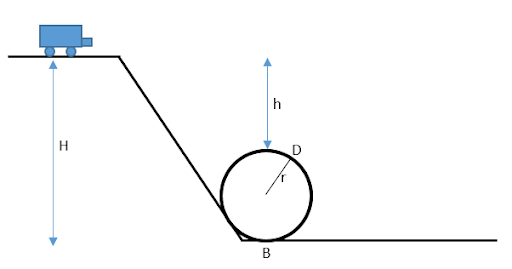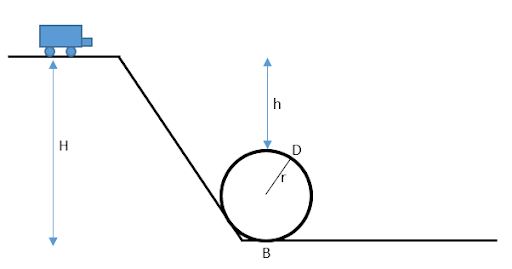
A toy car rolls down the inclined plane as shown in the above figure. It loops at the bottom. What is the relation between H and h?

A. \[\dfrac{H}{h} = 2\]
B. \[\dfrac{H}{h} = 3\]
C. \[\dfrac{H}{h} = 4\]
D. \[\dfrac{H}{h} = 5\]
Answer
224.7k+ views
Hint:When the path of the motion is frictionless then we use conservation of mechanical energy. To loop throughout the minimum velocity at the top of the loop be such that the produced centrifugal force balances the weight of the body.
Formula used:
\[K = \dfrac{{m{v^2}}}{2}\]
Here K is the kinetic energy of mass m moving with velocity v.
\[U = mgh\]
Here U is the gravitational potential energy of mass m at height h and g is the acceleration due to gravity.
Complete step by step solution:
The initial velocity of the car at height H is 0 m/s as it is at rest. Let the velocity of the car at the lowest point of the loop is \[v\]. Then using the conservation of mechanical energy of the car, the total energy of the car at height H will be conserved and will be equal to the mechanical energy of the car at the lowest point of the loop.

Image: The toy car rolls down
\[{E_{top}} = {E_{bottom}}\]
\[\Rightarrow {\left( {U + K} \right)_{top}} = {\left( {U + K} \right)_{bottom}}\]
\[\Rightarrow mgH + \dfrac{{m \times {{\left( 0 \right)}^2}}}{2} = mg \times \left( 0 \right) + \dfrac{{m \times {v^2}}}{2}\]
\[\Rightarrow v = \sqrt {2gH} \ldots \left( i \right)\]
As we know that to complete the loop the minimum velocity needed at the lowest point of the loop is equal to \[\sqrt {5gr} \]
So,
\[v = \sqrt {5gr} \ldots \left( {ii} \right)\]
From both the equations, we get
\[\sqrt {2gH} = \sqrt {5gr} \Rightarrow H = \dfrac{{5r}}{2} \ldots \left( {iii} \right)\]
From the shown figure,
\[H = h + 2r\]
Substituting 3rd equation, we get
\[h = \dfrac{{5r}}{2} - 2r \\
\Rightarrow h = \dfrac{r}{2} \ldots \ldots \left( {iv} \right)\]
From 3rd and 4th equations,
\[\dfrac{H}{h} = \dfrac{{\left( {\dfrac{{5r}}{2}} \right)}}{{\left( {\dfrac{r}{2}} \right)}} = 5\]
\[\therefore \dfrac{H}{h} = 5\]
Therefore, the correct option is D.
Note: We should be careful about the nature of the path of motion. If the path is frictional then the mechanical energy is lost as work done by the friction. The total mechanical energy of a system is conserved in accordance with the principle of mechanical energy conservation, which states that energy cannot be created or destroyed and can only be internally transformed from one form to another if the forces acting on the system are conservative in nature.
Formula used:
\[K = \dfrac{{m{v^2}}}{2}\]
Here K is the kinetic energy of mass m moving with velocity v.
\[U = mgh\]
Here U is the gravitational potential energy of mass m at height h and g is the acceleration due to gravity.
Complete step by step solution:
The initial velocity of the car at height H is 0 m/s as it is at rest. Let the velocity of the car at the lowest point of the loop is \[v\]. Then using the conservation of mechanical energy of the car, the total energy of the car at height H will be conserved and will be equal to the mechanical energy of the car at the lowest point of the loop.

Image: The toy car rolls down
\[{E_{top}} = {E_{bottom}}\]
\[\Rightarrow {\left( {U + K} \right)_{top}} = {\left( {U + K} \right)_{bottom}}\]
\[\Rightarrow mgH + \dfrac{{m \times {{\left( 0 \right)}^2}}}{2} = mg \times \left( 0 \right) + \dfrac{{m \times {v^2}}}{2}\]
\[\Rightarrow v = \sqrt {2gH} \ldots \left( i \right)\]
As we know that to complete the loop the minimum velocity needed at the lowest point of the loop is equal to \[\sqrt {5gr} \]
So,
\[v = \sqrt {5gr} \ldots \left( {ii} \right)\]
From both the equations, we get
\[\sqrt {2gH} = \sqrt {5gr} \Rightarrow H = \dfrac{{5r}}{2} \ldots \left( {iii} \right)\]
From the shown figure,
\[H = h + 2r\]
Substituting 3rd equation, we get
\[h = \dfrac{{5r}}{2} - 2r \\
\Rightarrow h = \dfrac{r}{2} \ldots \ldots \left( {iv} \right)\]
From 3rd and 4th equations,
\[\dfrac{H}{h} = \dfrac{{\left( {\dfrac{{5r}}{2}} \right)}}{{\left( {\dfrac{r}{2}} \right)}} = 5\]
\[\therefore \dfrac{H}{h} = 5\]
Therefore, the correct option is D.
Note: We should be careful about the nature of the path of motion. If the path is frictional then the mechanical energy is lost as work done by the friction. The total mechanical energy of a system is conserved in accordance with the principle of mechanical energy conservation, which states that energy cannot be created or destroyed and can only be internally transformed from one form to another if the forces acting on the system are conservative in nature.
Recently Updated Pages
Uniform Acceleration Explained: Formula, Examples & Graphs

JEE Main 2026 Session 1 Correction Window Started: Check Dates, Edit Link & Fees

JEE Isolation, Preparation and Properties of Non-metals Important Concepts and Tips for Exam Preparation

Isoelectronic Definition in Chemistry: Meaning, Examples & Trends

Ionisation Energy and Ionisation Potential Explained

Iodoform Reactions - Important Concepts and Tips for JEE

Trending doubts
JEE Main 2026: City Intimation Slip and Exam Dates Released, Application Form Closed, Syllabus & Eligibility

JEE Main 2026 Application Login: Direct Link, Registration, Form Fill, and Steps

Understanding the Angle of Deviation in a Prism

How to Convert a Galvanometer into an Ammeter or Voltmeter

Hybridisation in Chemistry – Concept, Types & Applications

Ideal and Non-Ideal Solutions Explained for Class 12 Chemistry

Other Pages
JEE Advanced Marks vs Ranks 2025: Understanding Category-wise Qualifying Marks and Previous Year Cut-offs

Laws of Motion Class 11 Physics Chapter 4 CBSE Notes - 2025-26

Mechanical Properties of Fluids Class 11 Physics Chapter 9 CBSE Notes - 2025-26

Units And Measurements Class 11 Physics Chapter 1 CBSE Notes - 2025-26

JEE Advanced 2026 - Exam Date (Released), Syllabus, Registration, Eligibility, Preparation, and More

JEE Advanced 2026 - Exam Date (Released), Syllabus, Registration, Eligibility, Preparation, and More




